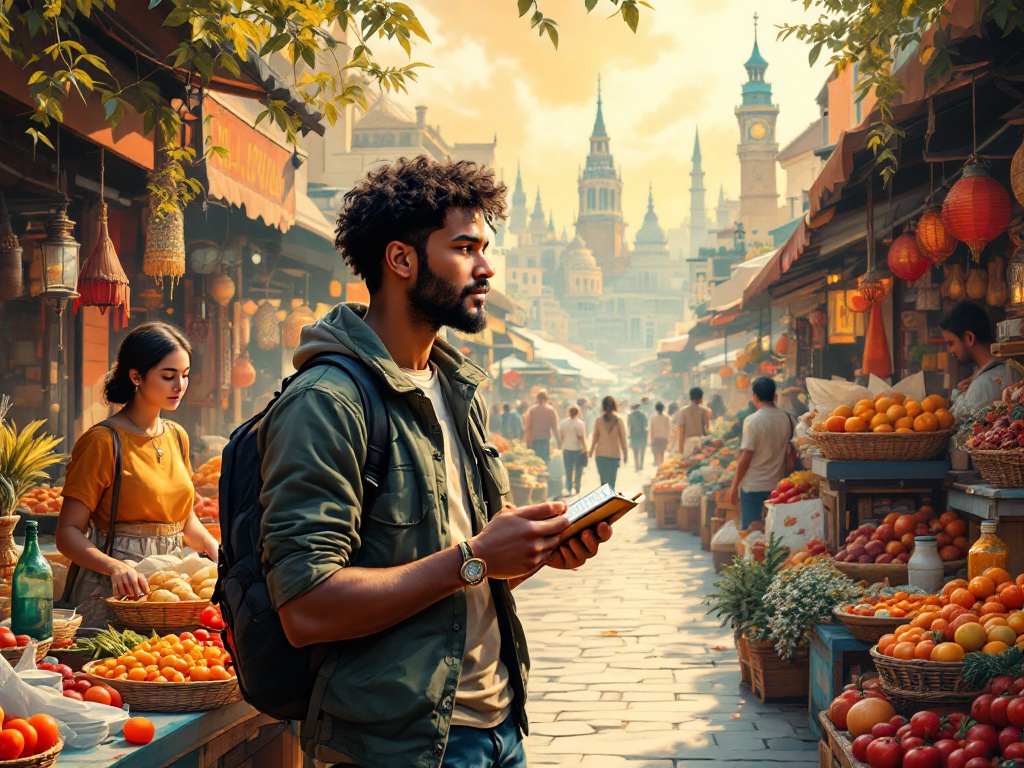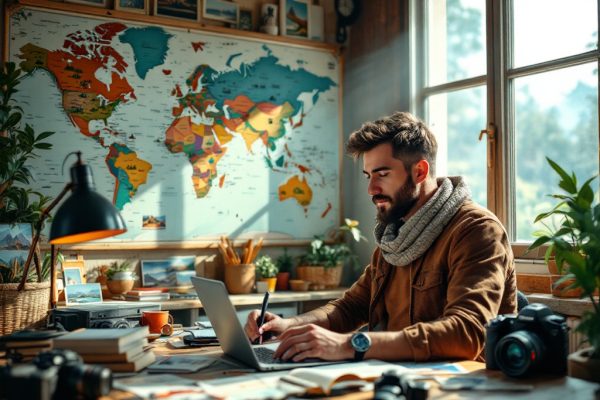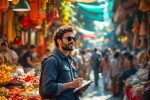Interesting Facts About Traveling the World as a Journalist
Dream of seeing the world and writing about it? Travel journalism offers exciting adventures, exploring diverse cultures and uncovering hidden gems. But it’s more than glamorous trips; it demands dedication, adaptability, and hard work. Discover the realities of this challenging yet rewarding field, from pre-trip planning and on-the-ground hurdles to crafting compelling stories and capturing captivating visuals. Explore the essential skills, the behind-the-scenes efforts, and the impact travel journalism has on enriching the global travel experience. Ready to embark on this journey? Dive in and uncover the world of travel journalism.
Important information

- Travel journalism demands strong writing, research, and adaptability, often with long hours and modest pay.
- Extensive pre-trip planning and meticulous on-the-ground reporting are essential for success.
- Journalists must balance immersive travel experiences with objective reporting and tight deadlines.
- The goal is to create compelling stories that capture a destination’s essence, inspiring readers to explore the world.
- Adaptability and resourcefulness are key to overcoming logistical challenges and cultural differences.
The Essentials of Travel Journalism
Aspiring travel journalists need more than a passion for exploring and strong writing skills. It’s a demanding career path, often with modest compensation. Adaptability is crucial for navigating unforeseen challenges. A valid passport is absolutely essential for any international travel.
More Than Passion and Writing Ability
Travel journalism blends a passion for travel and writing with dedication, adaptability, and hard work. A strong work ethic is key to success in this demanding field.
The Hard Work Behind the Scenes
Travel journalism offers exciting adventures, but it also demands dedication and hard work. Extensive research and planning are essential before embarking on any trip. While journalists meticulously prepare, unexpected logistical hurdles like flight delays and transportation breakdowns are common. Under constant pressure to deliver top-notch content, they simultaneously manage complex travel arrangements, often working long hours in challenging conditions. Their resilience is constantly tested as they strive to capture compelling stories and captivating visuals. Beyond the glamorous facade, significant effort goes on behind the scenes. Travel journalists spend considerable time researching, writing, and editing their work. Networking is crucial, as is navigating unfamiliar places and adapting to new cultures. Overcoming language barriers adds another layer of complexity. Ultimately, travel journalism is a rewarding career, but one that requires both skill and unwavering commitment.
The Allure of Travel Journalism
Travel journalism offers exciting adventures and the opportunity to experience different cultures. It allows journalists to capture compelling stories and captivating visuals, sharing their experiences with a wider audience.
The Challenges of Travel Journalism
Travel journalism demands dedication, hard work, and resilience. Journalists face constant pressure to deliver top-notch content while managing complex travel arrangements, often working long hours in challenging conditions. They must overcome logistical hurdles, language barriers, and adapt to new cultures. Extensive research, planning, writing, and editing are essential parts of the job.
Pre-Trip Preparations
Extensive research and meticulous planning are crucial before embarking on any trip. This includes researching destinations, securing visas, booking flights and accommodations, and developing a content strategy.
On-the-Ground Challenges
Travel journalists frequently encounter unexpected logistical hurdles, such as flight delays and transportation breakdowns. They must be adaptable and resourceful in overcoming these challenges while maintaining a professional demeanor.
Content Creation
Under constant pressure to deliver high-quality content, travel journalists work long hours in often challenging conditions. They must capture compelling stories, captivating visuals, and conduct interviews, all while managing their travel logistics.
Post-Trip Tasks
Significant behind-the-scenes work goes into producing travel content. This includes writing, editing, and fact-checking articles, as well as managing social media and networking with other professionals.
Adapting to Challenges on the Road
A travel journalist’s world is one of constant flux. Itineraries change on a dime, language barriers pop up, and cultural nuances add layers of complexity. Being adaptable and resourceful is essential, as they navigate unknown territories and tackle unexpected hurdles. This career demands sharp problem-solving skills and the ability to think fast. A travel journalist must be prepared for unexpected changes in plans and possess the flexibility to adjust accordingly. Effective communication is crucial for navigating language barriers and understanding cultural differences. Resourcefulness is key to overcoming unforeseen challenges and finding solutions on the go. The ability to think quickly and solve problems effectively is essential in this dynamic field.
The Role of a Travel Journalist
Travel journalists transport readers to far-off lands, sharing valuable insights that enrich the travel experience. Through vivid reports, articles, and chronicles, they capture the essence of a place, exploring its cultural values, savoring local cuisine, and examining environmental issues with journalistic integrity. Their work might include insightful columns, compelling photo essays, or contributions to popular travel guides.But travel journalists go beyond the typical tourist itinerary, unearthing hidden gems often overlooked by casual observers. They delve into the cultural, historical, and social fabric of a destination. Meticulous research combined with personal anecdotes adds depth and authenticity to their storytelling, inspiring readers to embark on their own adventures.
The Power of Photography
Photography plays a vital role in travel journalism, vividly conveying the richness of each experience and enhancing the narrative’s impact. It allows readers to visualize the destination and connect with the story on a deeper level.
Essential Skills
Strong writing skills, coupled with unique perspectives and rigorous research, are essential tools of the trade. A passion for storytelling lies at the heart of travel journalism, driving the desire to share the world’s wonders with others.
Travel journalism distinguishes itself from other journalistic fields through its focus on travel, exploration, and culture. It’s about sharing the stories of places, their history, and their people. This sets it apart from areas like political or financial reporting.
Inspirational Storytelling
Travel journalists ignite a thirst for adventure by sharing captivating stories of diverse cultures and stunning destinations. Their vivid descriptions inspire readers to explore the world and experience its wonders firsthand. They encourage exploration and discovery, painting captivating pictures through evocative prose and inspiring readers to embark on their own transformative journeys.
Transmitting Knowledge and Insights
Travel journalists offer valuable insights into diverse cultures, current events, and practical travel advice. This enriches readers’ global understanding and helps travelers make informed decisions, from choosing destinations to planning trips. Furthermore, travel journalism promotes cultural awareness, bridging the gap between different societies. Diverse perspectives are essential for balanced and accurate reporting.
How Journalism Enhances World Travel
Travel journalism significantly enhances the global travel experience. It fosters cultural awareness, providing travelers with insights into local customs and traditions, ultimately promoting respectful cultural exchange. Journalistic endeavors create valuable resources like informative travel guides and insightful reviews. These resources offer practical advice on destinations and accommodations, enabling travelers to plan and navigate their trips effectively. Beyond practical tips, travel journalism offers fresh perspectives. It explores destinations beyond typical tourist hotspots to uncover hidden gems and share untold stories, enriching the travel experience. Furthermore, by highlighting local businesses, community initiatives, and cultural events, travel journalists facilitate more authentic and immersive experiences, deepening travelers’ understanding of the places they visit.
Fostering Cultural Awareness
Travel journalism offers a window to the world, providing glimpses into local customs and traditions. Sharing unique perspectives educates travelers about the nuances of different cultures, encouraging respectful interactions and a deeper appreciation for the places they visit. This crucial understanding breaks down stereotypes and promotes cross-cultural understanding, highlighting the vital importance of preserving our cultural heritage.
Creating Informative Travel Guides and Reviews
Travel guides and reviews, crafted by journalists through firsthand exploration and research, are essential resources for travelers. These writers immerse themselves in local cultures, evaluating accommodations and attractions to create comprehensive guides. This information empowers travelers to make informed decisions, uncover hidden gems, and enjoy richer travel experiences. Practical tips, such as transportation details and cultural insights, further enhance the guides’ value.
Providing New Perspectives on Destinations
Travel journalists offer a fresh perspective, venturing beyond typical tourist traps to delve into the cultural, historical, and social fabric of a place. They craft compelling narratives through meticulous research and firsthand experiences, inspiring readers to explore off the beaten path and discover more than just the typical attractions. By sharing insightful observations and personal reflections, they challenge preconceived notions and foster a deeper understanding of a destination’s true essence, enriching the reader’s appreciation.
Examples of Authentic Experiences
exploring local markets,
attending a traditional festival,
conducting interviews with local residents.
The Essence of Travel Journalism
It’s not just about presenting facts; it’s about capturing a place’s spirit. Travel journalism connects us to the world, broadening our horizons and encouraging exploration with open minds and hearts.
Challenges and Perceptions of Travel Journalism
Travel journalists face a unique challenge: immersing themselves in a destination while simultaneously reporting on it. This delicate balancing act requires meticulous planning and impeccable time management. They must seamlessly transition between experiencing the journey and objectively documenting it, striving to capture a location’s authentic spirit while adhering to deadlines. This often translates to late nights spent writing after days filled with exploration, conducting interviews amidst jam-packed itineraries, and constantly adapting to unforeseen circumstances. Adding to this complexity is the pressure to craft compelling content. While maintaining accuracy and objectivity, they must also ignite readers’ wanderlust. It’s a demanding yet fulfilling role, navigating the delicate balance between informing and inspiring. Through skill and passion, they deliver high-quality work that resonates with audiences.
Balancing Immersive Experiences with Reporting Duties
Travel journalists meticulously plan their trips and manage their time effectively. Throughout their journeys, detailed note-taking is crucial, allowing them to immerse themselves in the destination while maintaining journalistic objectivity. They blend personal experiences with factual reporting to craft authentic and accurate stories. For example, while exploring a local market, they document the vibrant sights and sounds, along with their own feelings and reactions. This method ensures compelling narratives while upholding journalistic integrity.














